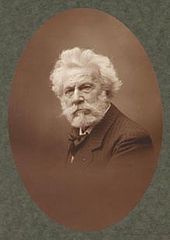Nicolas Camille Flammarion
| Camille Flammarion | |
|---|---|
 |
|
| Born |
Nicolas Camille Flammarion 26 February 1842 Montigny-le-Roi, Haute-Marne |
| Died | 3 June 1925 (aged 83) Juvisy-sur-Orge |
| Spouse(s) | Sylvie Petiaux-Hugo Flammarion Gabrielle Renaudot Flammarion |
Nicolas Camille Flammarion FRAS (26 February 1842 – 3 June 1925) was a French astronomer and author. He was a prolific author of more than fifty titles, including popular science works about astronomy, several notable early science fiction novels, and works on psychical research and related topics. He also published the magazine L'Astronomie, starting in 1882. He maintained a private observatory at Juvisy-sur-Orge, France.
Camille Flammarion was born in Montigny-le-Roi, Haute-Marne, France. He was the brother of Ernest Flammarion (1846–1936), founder of the Groupe Flammarion publishing house. He was a founder and the first president of the Société astronomique de France, which originally had its own independent journal, BSAF (Bulletin de la Société astronomique de France), first published in 1887. In January, 1895, after 13 volumes of L'Astronomie and 8 of BSAF, the two merged, making L’Astronomie the Bulletin of the Societé. The 1895 volume of the combined journal was numbered 9, to preserve the BSAF volume numbering, but this had the consequence that volumes 9 to 13 of L'Astronomie can each refer to two different publications, five years apart from each other.
The "Flammarion engraving" first appeared in Flammarion’s 1888 edition of L’Atmosphère. In 1907, he wrote that he believed that dwellers on Mars had tried to communicate with the Earth in the past. He also believed in 1907 that a seven-tailed comet was heading toward Earth. In 1910, for the appearance of Halley's Comet, he believed the gas from the comet’s tail "would impregnate [the Earth’s] atmosphere and possibly snuff out all life on the planet."
As a young man, Flammarion was exposed to two significant social movements in the western world: the thoughts and ideas of Darwin and Lamarck, and the rising popularity of spiritism with spiritualist churches and organizations appearing all over Europe. He has been described as an "astronomer, mystic and storyteller" who was "obsessed by life after death, and on other worlds, and [who] seemed to see no distinction between the two."
...
Wikipedia
